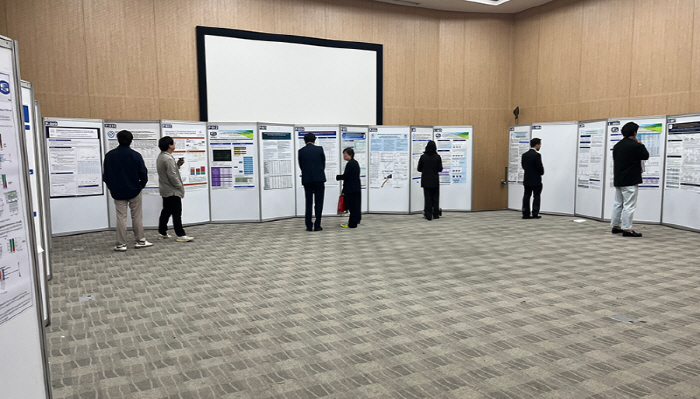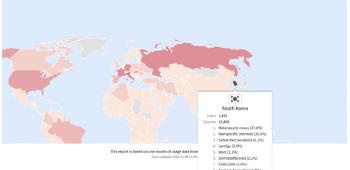A simple blood test suggests early screening of high-risk gastric cancer patients
May 26, 2025
A research team at Seoul National University Hospital proved the possibility of evaluating the severity of gastritis with simple blood tests, setting a new turning point for early non-invasive diagnosis of high-risk gastric cancer patients in the future.
The research team at Seoul National University Hospital (Professors Jeong So-yi, Kim Jeong, Song Ji-hyun, Lee Ju-young, Yang Sun-young, and Song Eun-young) presented the results of a study on the severity of atrophic gastritis (AG) using serum pepsinogen tests at the recently held poster session of the 「2025 Spring Conference of the Korean Society of Diagnostic Immunology」.
From January 2022 to March 2023, the study conducted a blood-based gastromarker test gastropanel on 500 people who underwent endoscopy at the Seoul National University Hospital's health examination center to analyze the levels of pepsinogen I, pepsinogen II, gastrin 17 and Helicobacter pylori infection.
In particular, according to the gastroscopy findings, the severity of atrophic gastritis was classified into 6 steps of the Kimura-Takemoto classification method, and the correlation of the ratio of pepsinogen I and II in the blood was analyzed. As a result, the Pepsinogen I and II ratio tended to decrease significantly as the severity of gastritis intensified, and when considering whether or not Helicobacter bacteria were eradicated together, the accuracy of the diagnosis was improved.
The research team explained that if the pepsinogen I and II ratio is less than 8.4, there is a high possibility of atrophic gastritis, especially when severe gastritis is suspected, it showed high specificity (92.2%) when it is less than 4.2.
In addition, in the analysis of patients with no history of Helicobacter eradication, the pepsinogen I and II ratio of 5.7 or less was the most effective in predicting severe gastritis.
These results show the potential of Gastropanel as a non-invasive diagnostic tool to evaluate the severity of atrophic gastritis and early screening of high-risk gastric cancer groups, and it is expected that it can be used as a basis for precision medical-based gastric cancer prevention strategies in the future.
A research team at Seoul National University Hospital stated, "Blood-based measurement of pepsinogen I and II ratio can be a useful means for non-invasive screening of high-risk groups for gastric cancer. It was recommended that selected high-risk gastric cancer patients undergo regular gastroscopy.'
An official from Dow Biomedica Co., Ltd. said, "This study shows that the gastrocnemius panel can function as a precision diagnosis tool that can contribute to customized treatment and prognosis management according to individual gastritis progression beyond simple gastritis diagnosis. The clinical value will be further highlighted as a non-invasive diagnostic tool for improving public health."
The research team at Seoul National University Hospital plans to more broadly verify the clinical effectiveness of the gastrocnemius-based gastric cancer prevention strategy through multi-center joint research in the future.
The research team at Seoul National University Hospital (Professors Jeong So-yi, Kim Jeong, Song Ji-hyun, Lee Ju-young, Yang Sun-young, and Song Eun-young) presented the results of a study on the severity of atrophic gastritis (AG) using serum pepsinogen tests at the recently held poster session of the 「2025 Spring Conference of the Korean Society of Diagnostic Immunology」.
From January 2022 to March 2023, the study conducted a blood-based gastromarker test gastropanel on 500 people who underwent endoscopy at the Seoul National University Hospital's health examination center to analyze the levels of pepsinogen I, pepsinogen II, gastrin 17 and Helicobacter pylori infection.
In particular, according to the gastroscopy findings, the severity of atrophic gastritis was classified into 6 steps of the Kimura-Takemoto classification method, and the correlation of the ratio of pepsinogen I and II in the blood was analyzed. As a result, the Pepsinogen I and II ratio tended to decrease significantly as the severity of gastritis intensified, and when considering whether or not Helicobacter bacteria were eradicated together, the accuracy of the diagnosis was improved.
The research team explained that if the pepsinogen I and II ratio is less than 8.4, there is a high possibility of atrophic gastritis, especially when severe gastritis is suspected, it showed high specificity (92.2%) when it is less than 4.2.
In addition, in the analysis of patients with no history of Helicobacter eradication, the pepsinogen I and II ratio of 5.7 or less was the most effective in predicting severe gastritis.
These results show the potential of Gastropanel as a non-invasive diagnostic tool to evaluate the severity of atrophic gastritis and early screening of high-risk gastric cancer groups, and it is expected that it can be used as a basis for precision medical-based gastric cancer prevention strategies in the future.
A research team at Seoul National University Hospital stated, "Blood-based measurement of pepsinogen I and II ratio can be a useful means for non-invasive screening of high-risk groups for gastric cancer. It was recommended that selected high-risk gastric cancer patients undergo regular gastroscopy.'
An official from Dow Biomedica Co., Ltd. said, "This study shows that the gastrocnemius panel can function as a precision diagnosis tool that can contribute to customized treatment and prognosis management according to individual gastritis progression beyond simple gastritis diagnosis. The clinical value will be further highlighted as a non-invasive diagnostic tool for improving public health."
The research team at Seoul National University Hospital plans to more broadly verify the clinical effectiveness of the gastrocnemius-based gastric cancer prevention strategy through multi-center joint research in the future.
|
This article was translated by Naver AI translator.














